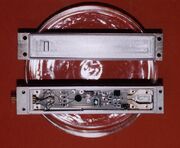Assessment |
Biopsychology |
Comparative |
Cognitive |
Developmental |
Language |
Individual differences |
Personality |
Philosophy |
Social |
Methods |
Statistics |
Clinical |
Educational |
Industrial |
Professional items |
World psychology |
Biological: Behavioural genetics · Evolutionary psychology · Neuroanatomy · Neurochemistry · Neuroendocrinology · Neuroscience · Psychoneuroimmunology · Physiological Psychology · Psychopharmacology (Index, Outline)
SQUIDs, or Superconducting Quantum Interference Devices, are used to measure extremely small magnetic fields; they are one of the most sensitive magnetometers known, with noise levels as low as 3 fT·Hz−½. While a typical fridge magnet is ~0.01 tesla (10−2 T), some processes in animals produce very small magnetic fields; typically sized between a microtesla (10−6 T) and a nanotesla (10−9 T). SQUIDs are especially well suited for studying magnetic fields this small. Their sensitivity was recently (in 2002) surpassed by SERF atomic magnetometers.
History and Design[]
The DC SQUID was invented in 1964 by Robert Jaklevic, John Lambe, Arnold Silver, and James Mercereau of Ford Research Labs after B. D. Josephson postulated the Josephson effect in 1962 and the first Josephson Junction was made by John Rowell and Philip Anderson at Bell Labs in 1963. The RF SQUID was invented in 1965 by James Edward Zimmerman and Arnold Silver at Ford.
There are two main types of SQUID: DC and RF (or AC). RF SQUIDs have only one Josephson junction whereas DC SQUIDs have two or more junctions. This makes DC SQUIDs more difficult and expensive to produce, but DC SQUIDs are much more sensitive.
Most SQUIDs are fabricated from lead or pure niobium. The lead is usually in the form of an alloy with 10% gold or indium, as pure lead is unstable when its temperature is repeatedly changed. The base electrode of the SQUID is made of a very thin niobium layer, formed by deposition, and the tunnel barrier is oxidised onto this niobium surface. The top electrode is a layer of lead alloy deposited on top of the other two, forming a sandwich arrangement. To achieve the necessary superconducting characteristics, the entire device is then cooled to within a few degrees of absolute zero with liquid helium.
More recently developed "high temperature" SQUIDS are made of a substance called YBCO (chemical formula YBa2Cu3O7-x), and are cooled by liquid nitrogen which is cheaper and more easily handled than liquid helium. They are less sensitive than conventional "low temperature" SQUIDS but many applications do not require the extreme sensitivity of the LT SQUID.

A prototype of a Semiconductor Superconducting Quantum Interference Device (SQUID).
The basic principle of operation is closely linked to flux quantisation. In this phenomenon, favoured flux states within a loop of superconductor are a multiple of the flux quantum.
Uses for SQUIDs[]
The extreme sensitivity of SQUIDs make them ideal for studies in biology. Magnetoencephalography (MEG), for example, uses measurements from an array of SQUIDs to make inferences about neural activity inside brains. Because SQUIDs can operate at acquisition rates much higher than the highest temporal frequency of interest in the signals emitted by the brain (kHz), MEG achieves good temporal resolution.
See also[]
References & Bibliography[]
Key texts[]
Books[]
Papers[]
Additional material[]
Books[]
Papers[]
External links[]
- da:Dc-squid
de:SQUID es:SQUID nl:SQUID sv:SQUID
| This page uses Creative Commons Licensed content from Wikipedia (view authors). |